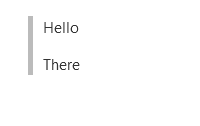Folks,
Unfortunately I have wasted years trying to seek change due to a particular bugbear of mine. I am also confident it causes problems for new users. Let me illustrate rather than explain.
[edit] for clarity I make another attempt to demonstrate the problem below
Line one
Line two
Line three
Renders as
Line one Line two Line three
I can treat each line as a sentence, ie break at the end of the line using say bullets;
* Line one
* Line two
* Line three
It basically renders as expected
In fact most (if not all) wikitext markup that starts with a character at the beginning of a line treats it as a sentence until it reaches \n end of line. However all transform the line in someway and to generate space above or below the line.
In the following example I suggest having a “dot sentence” but of course another character unlikely to appear at the beginning of the line could be used.
. Line one
. Line two
. Line three
.Line one
.Line two
.Line three
which would render as;
Line one
Line two
Line three
Line one
Line two
Line three
This should also allow us also to add the .classname after the character as is possible for most wikitext
.Line one
..classname<space>Line two
.<space>Line three
I will just leave this suggestion there and ask if anyone can see the need and value in such an extension to wikitext markup where we have no way to indicate a line is to be treated not as just a continuation of the above line nor a paragraph but an in between, a simple “sentence”.
Background
I think I mistakenly asked for a “dot paragraph” before, I do not want this.
which would render as;
Line one
Line two
Line three


